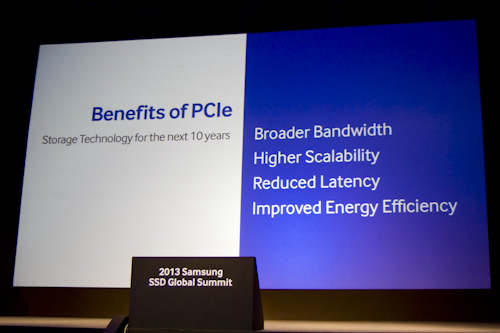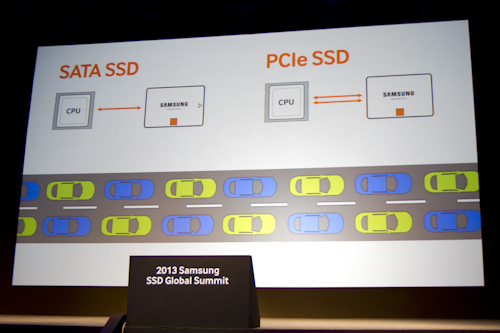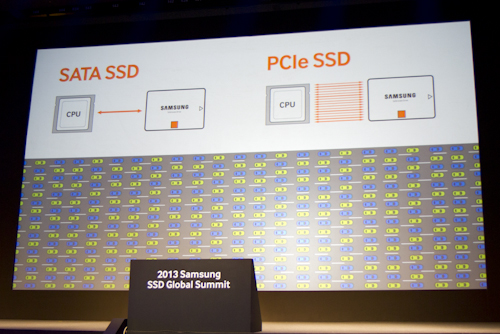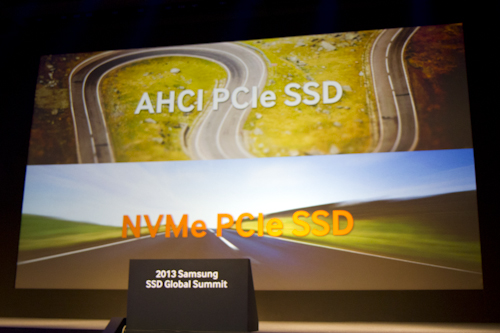Samsung's SSD Global Summit: The Leader In NAND Speaks Up
The theme of this year's Samsung SSD Global Summit, in Seoul, Korea, was SSDs For Everyone. More than 100 journalists from around the world showed up for this one-of-a-kind event, where we got a taste of the future in solid-state storage.
Life Beyond SATA And AHCI
During our time at Samsung's SSD Summit, we looked at (but didn't touch) technologies that the company is expected to introduce over the next year. Like many of its competitors, Samsung is is investing heavily in next-generation protocols, physical interfaces, and form factors. PCI Express is where the company sees storage moving to next.
We've reviewed several PCI Express-based cards over the last year. Many of them were simply conventional SATA drives, bridged to communicate over PCI Express. The result was often very fast, but still dependent on SATA and AHCI. That's going to change in 2014, though.
Pictures are always worth a thousand words, right? Think of the physical connection and protocol like the lanes on a highway. SATA has a fairly restrictive limit on the number of pathways data can take. PCI Express is far more scalable, and you're able to combine lanes to create larger links, depending on the performance your application demands.
As protocols go, we've relied on AHCI for many years. The problem is that it was designed with spinning disks in mind, and not SSDs. As a result, we're already slamming up against the SATA interface's limits. In an effort to standardize solid-state drive access across PCI Express, 80 companies (led in part by Samsung), created the Non-Volatile Memory Host Controller Interface Specification. NVM Express, as it's called, is the first interface designed specifically with SSDs in mind.
The above slide has a lot of low-level detail describing NVMe, but there are two important points. First, AHCI adds an enormous amount of overhead and latency to commands and transfers, which simply aren't required when you're working with flash memory. The second one involves queuing. The AHCI protocol can only handle one queue with up to 32 commands. Even the fastest 15,000 RPM disk drives have access times in 5 ms range. Hammered by purely random accesses, a single queue with 32 commands is more than enough.
When it comes to solid-state storage, though, parallelism can almost be limitless. Most client-focused architectures employ eight-channel designs, but there's nothing preventing more complex controllers. In enterprise applications, specifically with PCIe add-in cards, the number of channels and NAND packages can be much higher. NVMe allows for 64,000 queues and 64,000 commands per queue!
Get Tom's Hardware's best news and in-depth reviews, straight to your inbox.
Current page: Life Beyond SATA And AHCI
Prev Page Samsung: Flexing Its Dominance In The NAND Market Next Page NVMe In The Enterprise: 3 GB/s Sequential Reads?-
ojas Well, i have 2.3 TB of writes and 4.36 TB of reads on my 120GB Intel 320 series SSD in the last year...no re-allocated sectors thus far.Reply
My 840 has about 0.41TB written to it, and i bought this drive a few months ago.
Anyway, looking forward to RAPID. -
Someone Somewhere @radiovan I read it as being that it's a replacement for AHCI/IDE - it'll still work with SATA.Reply
Anyone else find that this reads like an infomercial? -
Steveymoo Ahh Samsung, you're still not immune to the age old marketting technique of combining large breasted women with your technology, to catch men's eyes.Reply -
Onus Organizations with huge amounts of data to sift (e.g. Google, NSA, IRS) will want any speed they can get. Labs doing FCAT testing need ridiculous write speeds. For the rest of us, as individuals, if a bloated application like Word already loads in the blink of an eye, any faster simply doesn't matter. I hope a substantial focus can be placed on cost.Reply -
JPNpower CPUs GPUs are sort of slowing. this is the future. This is innovation at its hottest and fastest. Maybe it is competition as some say, as AMD is bogged down in processors, giving the leaders a healthy lead, but in flash, Samsung, Sandisk/Toshiba, and Micron are hot at it.Reply
Everyone wins. -
jabliese radiovan and SomeoneReply
NVMe is a protocol to work with PCIe. This is quite clear from the slides. What is PCIe? Do you remember your last video card upgrade? The slot your card plugged into was most likely a PCIe slot. NVMe has no business with SATA, and that's the way you want it to be. -
drewriley Reply11318974 said:No word on when we might be seeing the new vertical NAND in products?
Last year, Samsung touched on some new technologies that they were working on, but didn't share any insight during their latest summit,




